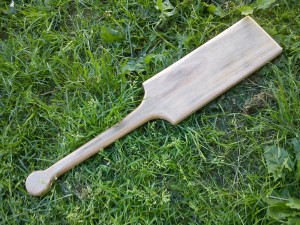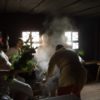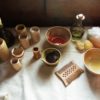…against the stench and the sweat: Doing laundry in late medieval times
Today we would like to show you some sources and techniques for doing laundry in the 14th and 15th century.
Moth control and Airing the laundry
To roughly clean especially woolen and pelt clothing and textiles, they were regularly hung out on a warm and dry day and shaken or beaten to avoid moths, mold or bad smell getting into the clothing. The Goodman of Paris recommends to never fold and stow away damp laundry (which as we know today is a paradise for moths. To air the clothing and pelts and get rid of dust and rough dirt, the laundry was hung up and beaten with rods or twigs.
And Lawrence Andrewe said about moths: “The Motte breeds among clothes until they have bitten it into pieces and it is a maniable worm, and yet it hides itse lf in the cloth so that it can scantly be seen and it breeds gladly in clothes that have been in an evil air, or in a rain or m ist, and so laid up without hanging in the sun or other sweet air after'”
Recipes on getting rid of stains
The Liber Illuministarum of Tegernsee abbey (around 1500), the Goodman of Paris (14th century) and the Nürmberger Kunstbuch (15th century) give us several recipes for getting rid of difficult stains before washing like fresh eggyolk, lime, urin, ash, verjus, cream of tartar, sulfur, spit, clay, milk, hot stones etc. for all kinds of different stains or discolorations, wax drops on fabric etc.
Renewing pale dyes:
A great article on our colleague Nikolaus’ blog
Soap
Austria, especially Vienna, was becoming a marketplace for mainly venetian soap in the 13th century. The soap was sold by apothecaries and grocers with a high margin.
Soap in its most simple form is of a pasty consistency and mostly made of ash lye and tallow. During the 13th and 14th century, soap on a plant oil base, which was usually made in Spain, but also France and Italy and imported into Austria in big volumes, took an important place in bodily hygiene.
Tallow based soap however was still mostly used for laundry, as well as ash lye and natron lye.
We also know of mixtures of several chemicals and fats. A recipe from 1389 f.e. uses wood ash, lime and hard water as well as alum, tallow, pot ash and olive oil.
Washing white laundry
White laundry was usually washed in a wooden tub or a kettle where lye from sieved ash and hot water were mixed to the required strength and the laundry was left in the tub for a time, depending on how dirty it was. Sometimes the water was reheated several times to guarantee a good result.
Afterwards, with the lye still in the fabric, the laundry was beaten on a bench or stone by the river with a laundry paddle to drive the lye through the fibres and get rid of difficult stains.
Afterwards, the laundry was carried to a waterstream and flushed with clear water.
One very important part of washing white laundry was the bleaching after each wash. The linnen was spread on a meadow to lie in the sun and kept wet until the afternoon so the sun could bleach all the remaining stains and discolorations. Some villages had their own community bleaching meadows for this task where also fresh fabric was bleached in long trains.
Sulfur steam could also be used for bleaching.
Stamping laundry
The Goodman of Paris describes a procedure to stamp laundry with a house sign, probably in order to recognize the houses laundry when washed by public laundry services.
Wäscheduft
Wheiter against moths or merely for good smell, different text sources give us hints about fragrant flowers, herbs and resins being put into closets and chests between the laundry.
“If you want to put roses inbetween the laundry, the roses from Provins are the best”, writes the Goodman of Paris and Lawrence Andrewe writes in his 15th century works: “The herbs that are bitter and strongly smelling are good to lay among such clothes, as the bay leaves, cypress wood.”
John Gerard recommends in his “Leechbook” the leaves and branches of cottonweed (or cudweed), golden mothwort (or cudweed) sweet trefoile, rosemary, wormwood and sea wormwood, sweet willow ‘whole shrub fruit and all’, shavings of wood and the resin from the cypress tree.
Sources:
- Bartl, Anna: Der “Liber illuministarum” aus Kloster Tegernsee; Franz Steiner Verlag, 2005
- Power, Eileen: The Goodman of Paris. Le Menagier de Paris. A Treatise on Moral and Domestic Economy by a Citizen of Paris 1393); The Folio Society, 1992
- Netherton, Robin: Medieval Clothing and Textiles 2: “Textile Cleaning Techniques“ p.102-119; Boydell Press 2006
- http://www.florilegium.org/?http%3A//www.florilegium.org/files/CRAFTS/Soapmakng-CMA-art.html
More reading:
- A collection of illuminations showing laundry
- http://www.dammer.info/Seifenherstellung_im_Mittelalter.pdf
- http://seifenlabor.bplaced.net/Seyfensieder/PDF/Seifen%20im%20Mittelalter.pdf
- http://www.seifen.at/
- Brenker Fabian – Waschen und Fleckentfernung von Textilien um 1500

Wäschebleuel aus Buchenholz, Rekonstruktion nach Abbildungen des 14./15. Jh. (z.B. Holkham-Bibel) im Vergleich mit bäuerlichen Geräten der Neuzeit, hergestellt von Niko H.
More on the constructin of our laundry paddle can be found here.
Related Posts
The following posts might interest you as well:








